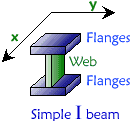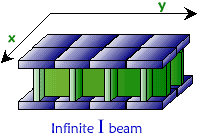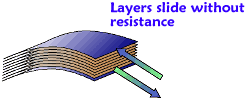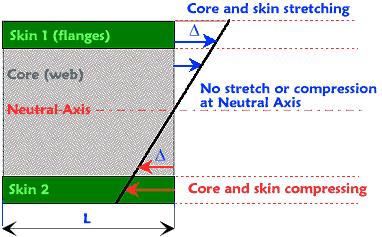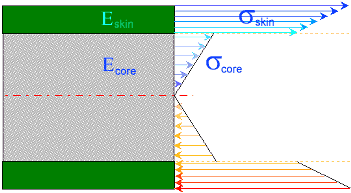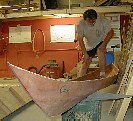| |
In order
to do this comparison, one more principle must be clarified:
The Applied bending force (Moment)
produces internal reaction forces in the panel (the blue and red arrows) that counteract
such bending. Since there is no acceleration in statics problem like this, it just happens that
the sum of the internal forces(moments) must be equal to the applied
bending force(moments) . In engineering terms, the forces are in 'equilibrium'
or balance.
This sum of internal forces is also graphically equivalent to the area
covered by the 'force arrows'.
Moments are defined as force x distance (arm) and represent bending only,
as in this case.
Now, let's take this single skin fiberglass below and compare it to the sandwich core. The thickness
of the panel is equivalent to three skins of the sandwich. In reality, the solid fiberglass panel
would have to be far thicker to have acceptable thickness and stiffness but for the sake of the
example let's say it is three layers.
The main point to take into account is that this lay-up will be as heavy or heavier than the sandwich.
This is because the density (lb/in^3) of the skins can be 3 to 6 times that of the core.
Since the fiberglass is subject to the same bending moment as the sandwich, the area covered
by its force arrows is also the same. It may be of different shape because the entire panel
is made of 'homogenous' material but the sum of the internal reaction
forces is identical!

Finally, compare the length of the longest arrows on the sandwich and the fiberglass panel. The
fibers in the surface of the fiberglass panel are stressed far more (max. stress) than in the
sandwich.
The conclusion:
- Even though both the sandwich core and the fiberglass are subject
to the same bending, the surface fibers in the single skin fiberglass
are stressed more thus they will also stretch more. The skin will mostly
bend or break. The panel will be far less stiff and strong than the
sandwich.
- Conversely, if the single skin fiberglass is assumed stiff enough, it can be substituted by
much lighter sandwich core panel. In order for the maximum stresses (longest arrows) to be equal,
far thinner and lighter skin is required in the sandwich.
|


